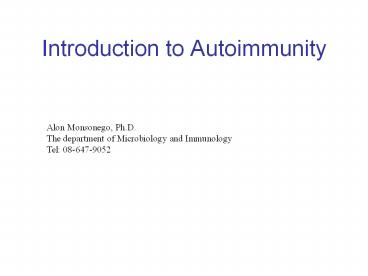Introduction to Autoimmunity - PowerPoint PPT Presentation
1 / 61
Title:
Introduction to Autoimmunity
Description:
Introduction to Autoimmunity Alon Monsonego, Ph.D. The department of Microbiology and Immunology Tel: 08-647-9052 Topics: T-cell selection T-cell activation T-cell ... – PowerPoint PPT presentation
Number of Views:86
Avg rating:3.0/5.0
Title: Introduction to Autoimmunity
1
Introduction to Autoimmunity
Alon Monsonego, Ph.D. The department of
Microbiology and Immunology Tel 08-647-9052
2
Topics
- T-cell selection
- T-cell activation
- T-cell regulation
3
- The Development and
- Survival of Lymphocytes
4
Figure 7-2 part 1 of 2
The development of T cells
5
Figure 7-2 part 2 of 2
6
Figure 7-8 part 1 of 2
The cellular organization of the human Thymus
7
Figure 7-9
8
Figure 7-10
The thymus is critical for T-cell maturation
9
Figure 7-12
Changes in cell surface molecules throughout
T-cell maturation in the Thymus
10
Figure 7-14
11
Figure 7-32 part 1 of 2
Positive selection in the thymus
12
Figure 7-32 part 2 of 2
13
Figure 7-35
Negative selection in the thymus by bone marrow
derived cells
14
Figure 7-36
15
Figure 13-9
Expression of AIRE in the thymus shape the immune
repertoire
16
Summary
- Lymphocytes originate in the bone marrow.
- B cells mature in the bone marrow
- T cells mature in the thymus
- Positive and negative selection mechanisms shape
the lymphocyte repertoire
17
- T Cell-Mediated Immunity
18
Figure 8-3
dictate
Distribution of APCs in the lymph nodes
19
Figure 8-4
Naïve T cells encounter antigen in the peripheral
lymph node
20
Figure 8-13
Two signals are required to induce T-cell
activation
21
Figure 8-14
DCs maturation as APCs
22
Figure 8-15
23
Figure 8-21
T-cell tolerance to antigens expressed on tissue
cells
24
Figure 8-24
Activation of CD4 T cells
25
Figure 8-31
Effector T cells with different functions
26
Figure 8-32 part 1 of 3
T-cell cytokines
27
Figure 8-32 part 2 of 3
28
Figure 8-32 part 3 of 3
29
Molecular differentiation of Th1,Th2, and Th17 T
cells
30
Summary
- Antigens are processed and presented to T cells
by professional APCs (B cells, Mac, and DCs). - Two signals are required to induce T-cell
activation by APCs. - The inflammatory environment shapes the
activation of both T cells and APCs - The function of T cells (CD4/CD8) differs
primarily according to their cytokine profile.
31
- Mechanisms of autoimmune diseases
32
Figure 13-1
33
Figure 13-6
34
Figure 13-31
35
Figure 13-3
T-cell mediated paralysis in a mouse model of
multiple sclerosis
36
Figure 13-34
37
Mechanisms of immune regulation
- Regulatory T cells
38
Antigen receptors and the immunological synapse
The principal T cell membrane proteins involved
in antigen recognition and in responses to
antigens are shown. The functions of these
proteins fall into three groups antigen
recognition, signal transduction, and adhesion.
39
Figure 13-14
By stander suppression
40
CD4CD25 cells
- About 5-10 of CD4 cells.
- Generated in the thymus possibly via high
affinity interactions with self ligands presented
by thymic stromal cells. - Extensive proliferation in vivo depending on the
presence of specific Ag. - Their development and maintenance is highly
dependent on costimulation and IL-2. - Express CD25, TNFa receptor, CTLA-4, and Foxp3.
- MicroRNAs are involved in their differentiation.
41
Mechanism of action
- Antigen specificity is unknown but most likely
selected and respond to self Ags. - Suppression is contact and also cytokine
dependent (TGF-b/ IL-10). - Act in tissues to control inflammation via direct
effects on effector T cells or DCs.
42
Foxp3
- Highly enriched in CD4CD25 cells.
- Its expression induces Treg activity.
- Targeted disruption prevents Treg development and
results in autoimmune diseases in mice and humans
(IPEX-immune dysregulation, polyendocrinopathy,
enteropathy, X-linked). Leads to type-1 diabetes,
allergy, and other. - Induced by TGF-b in CD4CD25- cells and lead to
expansion of CD4CD25 in vitro and in vivo. - Foxp3 binds other transcrition factors such as
NFAT, AML1, RUNx1.
43
Different subsets of Tregs
CD4CD25 10 of CD4
44
A balance between regulation and activation
45
(No Transcript)
46
(No Transcript)
47
Figure 13-15 part 1 of 2
CD4CD25 regulatory T cells inhibit colitis
48
Figure 13-15 part 2 of 2
49
Anti-ergotypic T cells
CTLA-4-CD80/86
Treg
Teff
TCR-Ag
APC
TCR-Ag
MHC-Ag
TCR
Terg
TCR-Ag(HSP/CD25)
50
(No Transcript)
51
Tr1 cells
- Produce IL-10 already at 4 hr after activation.
- Express high levels of CTLA-4.
- CTLA-4 dependent production of TGF-b.
- Express both Th1 and Th2 chemokine receptors.
- Proliferate poorly following activation due to
autocrine effect of IL-10. - IL-15 induces their proliferation as well as high
levels of IL-2.
52
Mechanism of action
- Suppress T-cell proliferation via rapid secretion
of IL-10 and TGF-b. Suppression is reversed by
neutralizing abs. - Suppression of immunoglobulin by B cells.
- TCR ligation is essential for suppression.
- Suppression is more efficient with cell contact
and may be antigen non-specific.
53
(No Transcript)
54
(No Transcript)
55
Th3 cells
- TGF-b secreting cells in Peyers patches 24-48
hrs after low dose feeding of self Ag.
56
(Intraepithelial lymphocyte)
57
(No Transcript)
58
Figure 13-16
59
The role of costimulation in T-cell suppression
(1)
CTLA-4-CD80/86
Treg
Teff
TCR-Ag
APC
TCR-Ag
60
Costimulation 2.
CTLA-4-CD80/86
Treg
Teff
TCR-Ag
TCR-Ag
APC
IDO
Tryptophan
IDO-indoleamine 2,3-dioxygenase
61
Costimulation 3.
CTLA-4-CD80/86
CD80/86- CTLA-4
Teff
Teff
TCR-Ag
APC
TCR-Ag































